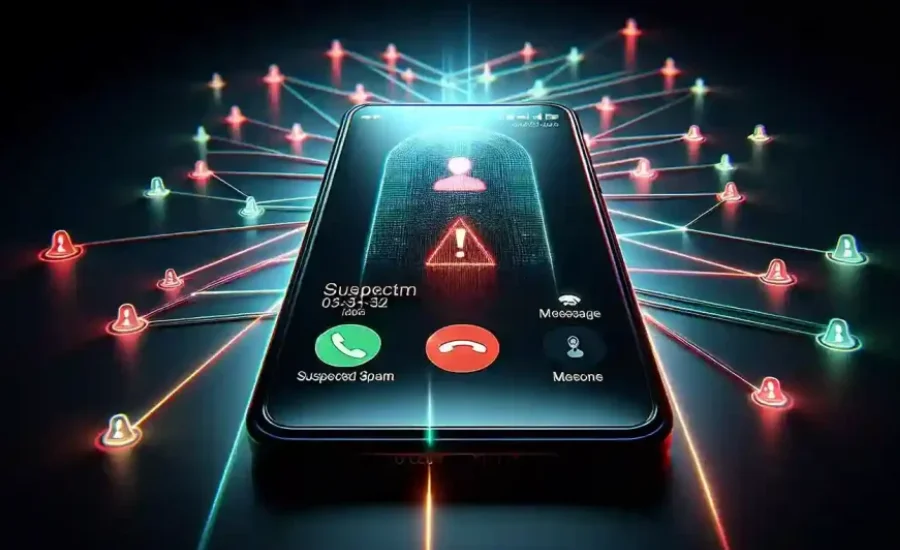The phone number 315-32-5526 is becoming more and more identifiable, and those who get calls from it frequently get frustrated. A typical element of today’s robocalls is hearing an automated system or hearing a prerecorded voice. This experience is known to many of us. Our experiences with phone contact have changed as a result of this growing trend, which makes these unwanted calls quite annoying.
This article aims to illuminate the nature of robocalls, particularly focusing on the infamous 315-32-5526. We will clarify what constitutes a robocall and how they operate, along with identifying key signs that can help you distinguish these automated calls from legitimate ones. Additionally, we will examine the impact of such calls on both consumers and businesses, delve into the regulatory framework governing robocalls, and offer actionable strategies for safeguarding yourself against these unwelcome disruptions. By the end of this discussion, you will be well-informed and better prepared to navigate the complexities associated with the 315-32-5526 robocall and its counterparts.
The Pervasive Problem of Robocalls: A Look at 315-32-5526
The number 315-32-5526 exemplifies a widespread issue, as robocalls infiltrate our everyday lives. These automated calls, which deliver pre-recorded messages to numerous recipients at once, utilize advanced computer systems to rapidly dial thousands of phone numbers. While they offer a quick means of communication, robocalls are often an unwelcome intrusion, highlighting a significant challenge in modern telecommunication.
The Diverse Landscape of Robocalls: Understanding 315-32-5526
Robocalls, such as those originating from 315-32-5526, manifest in numerous formats, each targeting specific audiences for varied objectives. While some automated calls provide beneficial services—like appointment reminders or notifications about flight cancellations—many are linked to scams or unsolicited marketing efforts. Data from the National Consumer Law Center reveals that Americans are inundated with over 33 million scam robocalls each day, totaling more than 50 billion annually.
The most prevalent types of robocalls include:
- Debt collection notifications
- Phishing attempts
- Healthcare and Medicare communications
- Political outreach during campaigns
- Requests for charitable donations
- Offers related to car warranties
- Loan-related scams
- Tech support fraud
Understanding these categories can help individuals identify and avoid unwanted interactions, ultimately leading to a more secure phone experience.
Recognizing and Avoiding Robocall Scams: The Case of 315-32-5526
While a considerable portion of calls from 315-32-5526 may be genuine, many of them are made with the intention of deceiving innocent people. It’s critical to be aware of common robocall scams that may jeopardize your money and personal data:
- IRS Impersonation Scams: Fraudsters pose as IRS officials, alleging that the recipient owes taxes and threatening legal consequences if immediate payment is not made.
- Social Security Fraud: Scammers claim there are issues with the recipient’s Social Security number and insist that it will be suspended unless urgent action is taken.
- Tech Support Scams: Callers act as tech support agents, asserting that the recipient’s computer is compromised by a virus and offering costly repair services.
- Travel Fraud: These calls promise free or significantly discounted vacations, often requesting credit card details to “secure” the offer.
- Loan Scams: Scammers entice individuals with promises of easy loans under favorable terms, primarily to gather sensitive information or upfront fees.
- Targeted Calls: Some robocalls specifically aim at Chinese-speaking individuals, using threats of deportation or legal consequences to extract money or personal data.
These types of schemes can have disastrous results. According to studies from 2022, over 68 million Americans lost over $29 billion as a result of these dishonest acts. The strategies used by con artists change along with technology, which emphasizes how crucial it is to stay aware and alert about any dangers.

The Technology Behind Robocalls: Dissecting the Process of 315-32-5526
Robocalls, including those from 315-32-5526, leverage sophisticated technology to efficiently connect with a large audience. The typical process involves several key steps:
- Gathering Numbers: Robocallers compile phone numbers from a variety of sources, such as public databases or purchased lists, to create a target audience.
- Automated Dialing: Using advanced autodialing systems, they can quickly dial thousands of numbers within a brief period.
- Delivering Messages: Once a call connects, a pre-recorded message is played, often crafted to mimic the tone and style of a human speaker.
- Live Transfer: If a recipient expresses interest in the message, some robocalls may transfer them to a live operator for further engagement.
To enhance the chances of recipients picking up their calls, robocallers frequently use deceptive strategies, such as caller ID spoofing. This technique enables them to alter the caller ID display, making it appear as though the call is originating from a known or trustworthy number. Consequently, many individuals are misled into answering calls they might otherwise dismiss.
The Tactics of Robocallers: Understanding Neighbor Spoofing and the Challenge of Blocking Calls from 315-32-5526
Robocallers, such as those originating from 315-32-5526, often employ tactics that leverage familiar number patterns to increase the chances of being answered. One common strategy is known as “neighbor spoofing,” where the caller uses numbers that mimic local area codes. For instance, if your phone number begins with 585, you might receive calls from other numbers that also start with 585, making them seem more recognizable.
It’s crucial to understand that simply blocking individual numbers like 315-32-5526 may not effectively eliminate robocalls. These callers frequently change their numbers with each attempt, complicating efforts to block them entirely. Many users have reported receiving numerous calls from different numbers in rapid succession, sometimes just minutes apart, illustrating the persistence and adaptability of these automated systems.
Identifying Robocalls: Recognizing the Threat of 315-32-5526
The number 315-32-5526 represents just one among the multitude of numbers associated with robocalls, which have become a significant nuisance for mobile users. To safeguard ourselves from these unwanted intrusions, it’s essential to learn how to recognize automated calls. Let’s explore some key indicators and effective strategies for identifying robocalls.
Key Indicators of Robocalls: Recognizing 315-32-5526
A clear indication that you are dealing with a robocall from 315-32-5526 is the presence of a pre-recorded message upon answering. If you encounter a robotic tone or a scripted message, it is highly likely that the call is automated. Another warning sign is the noticeable pause after you greet the caller, which occurs as the automated system connects the call to the pre-recorded content.
Robocalls frequently employ high-pressure tactics to compel immediate action, often claiming you have won a prize or alerting you to an urgent issue with your account. The Federal Trade Commission (FTC) has highlighted certain phrases to watch for, such as “You’ve been specially selected for this offer” or “You need to decide right now,” which can further signal the likelihood of a scam.
Effective Strategies for Combating Robocalls: The Role of Call-Blocking Apps
Many people are using call-blocking apps in reaction to the increase in robocalls, such as those from 315-32-5526. These programs use a variety of techniques to identify and stop possible robocalls from getting to your device. Here are a few popular choices:
- AT&T Call Protect: This complimentary app provides automatic fraud detection and alerts users to suspected spam calls.
- Hiya Caller ID and Block: Featuring automatic spam detection, this app also allows users to maintain a blacklist of unwanted numbers.
- RoboKiller: Leveraging AI-powered audio fingerprinting technology, RoboKiller analyzes incoming calls to identify and block known spammers, claiming to reduce spam calls by up to 99% within a week of activation.
- Truecaller: With a database of over seven million phone numbers, this app enables users to report spam and identify unwanted calls.
These applications often combine user reports, databases of known spam numbers, and sophisticated algorithms to identify potential robocalls. Many also offer additional features like reverse phone lookup and direct complaint filing with the Federal Trade Commission (FTC).
However, it’s vital to understand that robocallers, like those affiliated with 315-32-5526, are always altering their techniques. Even if these programs have many uses, there is no 100% guaranteed solution, therefore some robocalls could still get through. As a result, it’s critical to be vigilant and use a variety of strategies to shield yourself from these bothersome calls.
In summary, effectively identifying robocalls involves a blend of awareness, caution, and technological support. By recognizing the telltale signs of a robocall, understanding patterns like those associated with 315-32-5526, and utilizing call-blocking applications, you can significantly decrease the frequency of unwanted calls. When in doubt, it’s always safer to let suspicious calls go to voicemail.
Privacy Risks Associated with Robocalls: The Challenge of Numbers Like 315-32-5526
Robocalls, such as those originating from numbers like 315-32-5526, pose serious privacy threats. Scammers frequently exploit publicly accessible information—ranging from phone directories to social media profiles—to create detailed profiles of potential victims. This encroachment on personal privacy can leave individuals feeling exposed and vulnerable.
Compounding the issue is the advent of caller ID spoofing technology, which allows scammers to manipulate caller ID systems. By making it appear as though calls are coming from recognizable or trustworthy numbers, they complicate consumers’ efforts to effectively screen incoming calls. This not only hinders individuals’ ability to safeguard their privacy but also complicates regulatory enforcement efforts and the pursuit of these offenders by authorities.
The Overlooked Psychological Effects of Robocalls: Understanding the Impact of 315-32-5526
Though they can have significant effects, the psychological effects of robocalls, such as those from 315-32-5526, are frequently overlooked. Unwanted calls coming in nonstop can lead to tension, worry, and even melancholy. Certified psychologist Melanie Shapiro points out that persistent interruptions like this might trigger the body’s natural stress response, raising cortisol and adrenaline levels.
The effects are particularly noticeable for people who are already struggling with despair, anxiety, or feelings of loneliness. Unwanted calls have the potential to exacerbate these circumstances and cause further anxiety. Moreover, the apprehension of being a victim of fraudulent schemes leads to increased levels of anxiety and mistrust with every phone contact, promoting a continuous state of alertness and distrust.
Over time, this ongoing stress can have enduring effects on mental well-being. Individuals may develop an aversion to answering their phones, concerned that they might inadvertently share sensitive information or fall victim to financial schemes. This apprehension can extend to all forms of phone communication, potentially disrupting both personal relationships and professional interactions.
The psychological ramifications are so significant that they are altering our interactions with mobile devices. Alarmingly, a survey revealed that approximately 70% of Americans no longer respond to calls from unknown numbers. While this behavior may serve as a protective measure, it can also result in missed important calls and increased feelings of isolation.

In summary, the repercussions of robocalls, including those from numbers like 315-32-5526, reach far beyond simple annoyance. The financial losses, privacy concerns, and psychological effects create a complex web of challenges that affect individuals and society as a whole. As we navigate this issue, it remains essential to stay vigilant and implement measures to shield ourselves from these unwanted disruptions.
The Significant Financial Toll of Robocalls: A Closer Look at 315-32-5526
Robocalls, like those from 315-32-5526, have extremely negative financial effects. The predicted losses from spam calls in 2022 amounted to an amazing $65 billion, and predictions suggest that this amount would only rise in the years to come. The fact that these frauds are not limited to elderly individuals is one of their most alarming features. Younger generations are actually more vulnerable to these fraudulent scams, according to study. Millennials, Gen Z, and members of Generation X had a 34% higher likelihood of suffering financial losses as a result of fraud in 2021 than did people 60 years of age and older.
In 2021, the mean financial loss suffered by those between the ages of 18 and 59 was almost $500. But the financial effects are sometimes considerably more severe for elderly Americans. For instance, the median loss for those in the 70–79 age group was $800, but those in the 80+ age group reported enormous losses of $1,500 on average. The financial cost that robocalls inflict, especially on disadvantaged groups, is highlighted by these numbers, underscoring the critical need for comprehensive prevention and awareness campaigns.
Understanding the Legal Framework Surrounding Robocalls: The Role of the TCPA and Recent Legislation
The Telephone Consumer Protection Act (TCPA) remains as the cornerstone of federal regulation controlling robocalls, including those coming from numbers like 315-32-5526. Telemarketers are subject to severe restrictions under this legislation, especially with regard to the use of automated calling systems and prerecorded voice messages sent to home and mobile phone numbers, as well as unsolicited faxes and text messages. One of the main requirements of the TCPA is that marketing calls utilizing automated technology cannot be conducted without previous express written authorization.
To further enhance consumer protection, the Federal Communications Commission (FCC) has instituted rules mandating that callers secure written consent prior to placing any prerecorded telemarketing calls to either home or wireless numbers. Additionally, these regulations require that all such calls clearly disclose specific identifying information, including the name of the business making the call and its contact number.
In 2019, the enactment of the TRACED Act marked a significant step forward in combating robocalls. This legislation encourages telecommunications companies to adopt the SHAKEN/STIR system, a framework aimed at curtailing the ability of scammers to falsify caller ID information. As a result of this system, calls flagged as potentially suspicious are now displayed on recipients’ phones with alerts such as “scam likely” or “spam likely.”
Moreover, various states have begun to implement their own measures to tackle the issue of robocalls. For instance, Arkansas has enacted legislation imposing severe criminal penalties for unlawful call spoofing, along with establishing a regulatory framework for telecommunications providers to ensure compliance. This multi-faceted approach underscores the ongoing efforts to mitigate the impact of robocalls and safeguard consumer interests.
The National Do Not Call Registry: A Key Defense Against Robocalls
The National Do Not Call Registry is one useful tool for preventing robocalls, including those from the number 315-32-5526. By allowing users to register their landline and mobile phone numbers, this service seeks to reduce the amount of telemarketing calls. Even though it might not be able to stop all unsolicited calls—especially from con artists who often disobey the law—it is nevertheless a useful tool for reducing these interruptions. Visit the Federal Trade Commission (FTC) website to register your number. You can easily add your details to the registry there.
Effective Strategies for Minimizing Robocalls
To enhance our defenses against robocalls, including those originating from numbers such as 315-32-5526, we can implement several best practices:

Avoid answering calls from unfamiliar numbers. If you do pick up and suspect it’s a robocall, it’s best to hang up immediately.
Be wary of caller ID information. Scammers often employ “spoofing” techniques, which can mask their true identity by displaying a local or recognizable number.
Refrain from disclosing personal information over the phone, especially when responding to unexpected calls.
Utilize your phone’s built-in blocking capabilities. Many smartphones feature a “whitelisting” option, allowing only calls from your saved contacts to come through.
Report any suspicious calls to the FTC. This assists in monitoring patterns and taking action against offenders.
Consider enabling the “Do Not Disturb” feature on your device, which restricts incoming calls to only those from your contacts.
By adopting these strategies, we can greatly reduce the influx of unwanted calls, including persistent ones like 315-32-5526. While it may not completely eradicate all robocalls, these measures empower us to take charge of our phone interactions and safeguard against potential scams.
Staying informed and alert is crucial as scammers continually refine their methods. By merging the use of the Do Not Call Registry, call filtering technologies, and sound phone practices, we can establish a formidable barrier against unwanted robocalls.
Read More: Banana:b4hnuk08dew
Final Words
We must continue to take proactive measures to protect our personal information and peace of mind as robocalls get more complex. By familiarizing ourselves with useful measures, such as employing call-blocking tools, registering with the National Do Not Call Registry, and exercising care with unfamiliar callers, we may dramatically lessen the impact of these unwelcome intrusions.
Staying vigilant and informed is our best defense. By adapting our methods and sharing knowledge about potential threats, we can foster a safer communication environment for ourselves and our communities. Remember, every step taken towards awareness and prevention contributes to a collective effort in minimizing the disruption caused by robocalls. Stay alert, protect your information, and take control of your phone experience.
For more information Check It Out Discoveroutlooks
